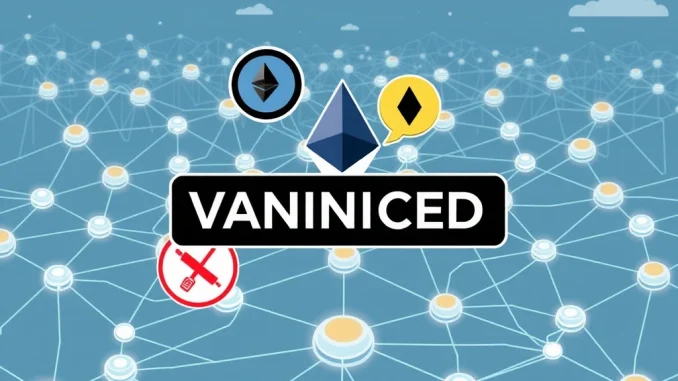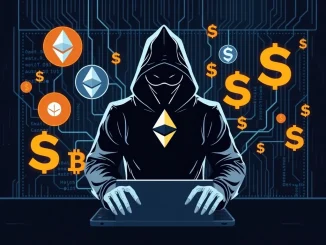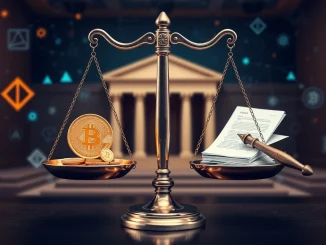
A recent event involving the ZKsync protocol has captured significant attention within the crypto community. The team behind the Ethereum scaling solution briefly posted, then quickly removed, a statement suggesting it was under a US regulatory investigation. This action has sparked discussions and concerns regarding the project’s status and the broader landscape of crypto regulation.
What Exactly Happened with the ZKsync Statement?
The core incident revolves around an X (formerly Twitter) post from the official ZKsync account. This post explicitly mentioned that the project was facing scrutiny from U.S. authorities. The concern, as stated in the now-deleted post, was reportedly related to zkEVM-based applications that were accessible to users in the United States.
Here’s a breakdown of the timeline and related events:
- A statement was posted on ZKsync’s official X account claiming a US regulatory investigation was underway.
- The post specifically cited concerns about zkEVM applications available to American users.
- Shortly after, the post was taken down without public explanation from ZKsync.
- Prior to or around the same time, the ZKsync X account reportedly experienced a brief security compromise, used to promote a fake ZK token airdrop.
- The fraudulent airdrop post was also quickly removed.
While the security incident involving the fake airdrop is a separate issue, its timing added to the confusion surrounding the regulatory statement’s appearance and subsequent removal. The focus for many observers quickly shifted to the implications of the deleted investigation notice.
Why Does a US Regulatory Investigation Matter for ZKsync?
Any mention of a US regulatory investigation is significant for a project operating in the cryptocurrency space, especially one like ZKsync which is a major player in Ethereum scaling.
Here’s why this is a big deal:
- **Regulatory Uncertainty:** The U.S. regulatory environment for crypto is still evolving. Investigations can lead to enforcement actions, fines, or restrictions on operations, potentially impacting the project’s growth and adoption, particularly among U.S. users and institutions.
- **Market Confidence:** News of regulatory scrutiny can erode investor and user confidence. The quick removal of the statement without clarity can amplify speculation and concern.
- **Implications for zkEVM:** The mention of zkEVM applications suggests regulators might be looking at the specific functionality or accessibility of certain dApps built on ZKsync, raising questions about how such applications are viewed under U.S. law.
- **Precedent Setting:** How ZKsync interacts with potential regulatory inquiries could set precedents for other Ethereum scaling solutions and Layer 2 networks utilizing similar technology.
The fact that the statement was removed is equally, if not more, intriguing than its initial appearance. It raises questions about whether the statement was posted in error, was premature, or was removed for strategic reasons.
Understanding ZKsync and zkEVM in the Context of Crypto Regulation
ZKsync is a prominent Layer 2 protocol designed to scale Ethereum by using zero-knowledge rollups (ZK-rollups). This technology bundles transactions off-chain and submits cryptographic proofs (specifically, validity proofs) to the Ethereum mainnet, significantly increasing transaction throughput and reducing costs.
zkEVM refers to a type of ZK-rollup that is compatible with the Ethereum Virtual Machine (EVM). This compatibility is crucial because it allows developers to easily port existing Ethereum decentralized applications (dApps) to the ZKsync network without extensive code changes. This ease of migration is a key factor in attracting developers and users to the platform.
The potential regulatory focus on zkEVM applications accessible to U.S. users could stem from various concerns, including:
- **Securities Law:** Regulators might be examining whether certain tokens or activities facilitated by dApps on ZKsync qualify as unregistered securities.
- **Money Laundering/KYC:** Concerns about the ability to identify users or track funds within these applications.
- **Specific Application Types:** Certain types of dApps (e.g., decentralized finance protocols offering specific services) might attract more regulatory attention than others.
The accessibility of these applications to U.S. persons is often a trigger for U.S. regulatory bodies like the SEC or CFTC.
Challenges and Actionable Insights
The ZKsync incident highlights several challenges facing crypto projects today:
- **Navigating Global Regulation:** Projects operating globally must contend with differing and often conflicting regulatory frameworks across jurisdictions.
- **Communication in Crisis:** Clear and timely communication is vital, especially when dealing with sensitive topics like regulatory inquiries or security incidents. The quick removal of the statement without immediate clarification created confusion.
- **Technical Complexity vs. Regulatory Understanding:** Explaining complex technologies like ZK-rollups and zkEVM in a way that regulators understand and are comfortable with is an ongoing challenge.
For users and investors, the actionable insight is the need for caution and due diligence. Events like this underscore the inherent risks in the crypto market, including regulatory risks and the potential for security breaches. Staying informed about a project’s communications (and lack thereof) is crucial.
The Broader Impact on Ethereum Scaling and Crypto Regulation
While this specific incident involves ZKsync, it has broader implications for the entire Ethereum scaling ecosystem and the relationship between blockchain technology and government oversight. As Layer 2 solutions become more integral to accessing Ethereum, they may face increased scrutiny.
The focus on applications accessible to U.S. users also reinforces the challenges projects face in geo-restricting services or ensuring compliance based on user location. This is a complex technical and legal hurdle.
This event serves as a reminder that regulatory risk is a significant factor in the crypto space and can impact even well-established projects using advanced technology like zkEVM.
Conclusion: What’s Next for ZKsync and Regulatory Clarity?
The removal of the US regulatory investigation statement by ZKsync leaves many questions unanswered. Was the post accurate? Why was it removed? What is the current status of any potential regulatory engagement?
The incident, coupled with the brief security issue, underscores the volatile nature of the crypto environment. For Ethereum scaling solutions like ZKsync, navigating technical development alongside the complex and often unpredictable world of crypto regulation will be key to long-term success and adoption.
The community awaits further clarity from ZKsync regarding both the regulatory statement and the security incident. Until then, the event serves as a stark reminder of the regulatory challenges that continue to shape the future of decentralized technology.



